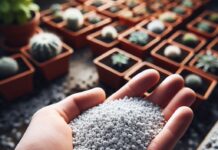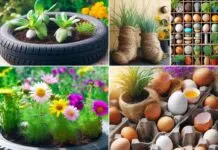Domestic Compost – How to Prepare it at Home?
Compost, the Wealth of the Garden
composting definition:
Recycle your organic waste and leftover food, as nature does, by composting. You will limit the amount of waste thrown out to be burnt in incinerators. You will save money, and you will bring a natural fertilizer to your garden, which will cost you nothing, instead of buying chemical industrial fertilizer. Not only will you produce a natural fertilizer for your plants, but you can also use it as mulch for your banks or as a substratum for your plantings, or in your vegetable patch.
Be careful, however, of the quantity you use as this compost is concentrated and may burn the roots of your plants. You should, therefore, mix it well with soil before spreading it.
You don’t necessarily need a composter to produce compost. Some local government offices or waste management agencies offer free composters. Check them out, or else make one yourself. Make a heap in the corner of your garden. There even exists small composters for apartments that can be placed on the balcony.
The maturation period lasts from 9 to 12 months and can be accelerated by adding nettle slurry if needed. Please put all your organic waste in it, and grind certain branches and leaves before adding them. Use a grinder or a lawnmower to break them down into small bits – this will help them decompose quicker.
At home, all your leftovers can be put into the composter – vegetables, fruit stones, eggshells, and even cardboard from paper rolls or toilet paper, corrugated cardboard without colored print (get rid of sellotape and staples, then tear the cardboard into small strips).
Compost is the wealth of the garden. By adding it to your soil, you will quickly notice microfauna’s development, which helps to decompose and ventilate the soil. Your plants will be particularly grateful for their abundant blossoming!
A Good Composting
The ingredients needed for a good breakdown of your compost are the following:
- heat, which allows a good development of bacteriae.
- Humidity. If the compost heap dries out in hot weather, add water
- air essential for the bacteria and fungi needed for decomposition. Turn your compost over every month. You will renourish the bacteriae by bringing the incompletely decomposed organic material on the outside of the heap into the heart of the compost
- insects like dung worms (their prominent rings can identify them), which play a big part in the decomposition process. Hold onto them!
- A lid or an opaque cover will increase the heat and maintain the humidity. This will also incite the worms to rise to the top of the heap.
The decomposition process gives off between 50°C and 70°C of heat. This heat destroys most viruses as well as the seeds of weeds.
You can buy compost decomposition activators or put a layer of nettles (without seeds) on top or use a nettle slurry.
Your compost will be ready for your plants after about six months of decomposition. Please don’t use all of it. Leave some good compost and its worms – these will repopulate the compost with good bacteria. If you use compost, which isn’t completely decomposed, mix it with some soil. If you don’t, some of your plants may die.
Some local government offices sell composters at a reduced price. Call them for information on the subject.
Read More: Everything You Need to Know About Ugly Produce
A Natural Composting Process :
Compost is a fermented blend of organic and mineral residue, used as fertilizer for the vegetable patch, the ornamental garden, or potted plants. It can be made at the bottom of the garden, in a heap, or in a composter. It can even be produced on the balcony in a worm composter that respects approved environmental norms.
Waste that can be used in my compost :
Household waste in general: paper towels, wood ash, sawdust, wood chips, indoor plants, etc…
Kitchen waste: vegetal peel (except that from citrus fruit), eggshells, coffee dregs, paper filters, dairy products, cheese crusts, vegetable leaves, rotten fruit and vegetables, bones, fishbones, etc…
Garden waste: grass clippings, leaves, wilted flowers, weeds, etc…
Around one-third of the waste in French bins can be composted.
The Advantages of Doing its Compost
Several home composting followers will tell you that they are always fascinated by the wonderful metamorphosis, which operates under their eyes. See Materials, which are regarded as waste, transform, literally in an extraordinary amendment that is the compost… is almost magic.
For some, it is equally captivating that the transition of the Chrysalis to the graceful butterfly or yet the transformation of the toad into a beautiful prince. Apart from this side fascinating, three excellent reasons should convince you to begin or continue this tremendous activity that is home composting.
This is protecting the environment, cost savings, and quality control of the finished product. The organic materials compostable such as residues from the kitchen and garden alone, represent, on average, 40 % of the garbage bag volume.
Materials Will be Processed in Composting
According to how these materials will be processed, they become waste or resources. While the composting process contributes to stabilizing the constituents, organic materials that take to the road from incinerators and landfill sites contribute to producing biogas responsible for the greenhouse effect. Similarly, the leachate water produced by the decomposition of organic materials is an important source of soil pollution since these entail contaminants.
Finally, the transport of thousands of tonnes of organic waste by truck also creates pollution. Do his compost; it is, without a doubt, a concrete gesture for the protection of the environment and, at the same time, to teach our children or grandchildren a concrete practice that will affect future responsible citizens.
The Economic Advantage of Compost
The economic advantage of home composting is also compelling. Considering that the cost of a bag of compost quality commercial, weighting 15 kg, is located around five dollars and that, on the other hand, a family of four persons generates an average of 672 kg of organic matter that is compostable per year,
it is 336 kg of compost (the composting process reduced by 50% the quantity of organic matter due to the loss of water), which can be manufactured by year, or the equivalent of 22 bags of compost commercial, for an economy of approximately $110 per year. Of course, this economy will be as interesting if the composting system’s investment is reasonable to this effect. We will see later if it is possible to manufacture a composter at a low cost.
Another excellent reason to do his compost is that we exercise direct control over the product’s quality. When it manufactures its compost, it uses only the correct ingredients; therefore, it attests to the quality of the finished product, which is not clear in the case of compost commercials.
The next section discusses the ingredients that it is possible to compost and those that it is better to avoid. Finally, when we think of all the benefits of home composting, it isn’t easy to understand why so few people engage in this.
Compostable materials are usually classified into either brown materials (rich in carbon) or green materials (rich in nitrogen). You will understand the reason for this differentiation in section 5, which deals with compost manufacturing.
Note that the terms “green” and “brown” do not necessarily refer to the color of the ingredient (although several meet these qualifiers) but rather to its category. Of course, it is not necessary to use all the materials in the list that follows. However, it is desirable to employ at least one ingredient of each of the two categories. Of course, the more you introduce different materials, the more your compost will be rich in mineral elements.
Vermicomposting
Vermicomposting is a composting method that enables the manufacture of compost for the interior with small redworms’ help (Eisenia foetida). The Worms are placed in a plastic container aerated, the vermicomposter, in a litter consisting of carbon-rich material such as shredded newspaper. They are then fed periodically with kitchen waste. After a few months, it results in a compost of high quality beneficial for indoor plants. This method is more complex and more limited than the home composting fact in the garden, but it may be appropriate for those who live in an apartment and have no land area to install a composter.
The Brown Materials (Rich in Carbon)
The brown materials that are sometimes called dry are, in fact, materials rich in carbon. These last are multiple; that is why they are considered essential ingredients in the manufacture of compost. First of all, they provide an essential element to micro-organisms carbon. Also, given their composition fibrous, they structure the final product.
Finally, they contribute to retaining the mineral elements which are likely to escape the green materials. When they constitute the first layer, materials rich in carbon retain the mineral elements liquids that would otherwise be leached to the ground. In contrast, if they are placed on the surface, they prevent some mineral elements’ volatility such that the nitrogen evaporates in the air.
Needles of Coniferous Trees
the needles of the pine, spruce and other conifers should be composted in restricted quantities because they are very acidic. Why not leave them at the base of your conifers and other acidophilic plants? They will make an excellent mulch… free.
Twigs and Branches
twigs and small branches that break easily in hand can be composted directly, while the branches with a diameter of 1 cm and more should be fragmented. If you have only a few branches from time to time, the pruning shears, the shears, or any other sharp tool will do very well in this case.
However, for significant quantities, you may need to have recourse to a shredder. Some municipalities offer the service of shredding branches to citizens and then offer them the product. Tell you! The branches as well as shredded are also very useful as mulch.
Wood shavings and sawdust of wood chips and sawdust are ingredients very rich in carbon. Therefore, they are difficult to compost; that is why the latter’s volume should not exceed 10% of the total volume of materials to composting.
To avoid chips and sawdust from painted wood, complexion, treaty, or plywood.
Leaves
Dead leaves are an important input to the compost. Since they are present in abundance in the fall, it is ideal for you to reserve in anticipation of the coming season. Do you not have sheets on your land? That would not stop; go to make a tour in a forested area of your municipality or even your neighbor before the garbage collection, and make your choice in the bags at your disposal.
Have no fear, nobody you will acknowledge of vol. In passing, it would be time that you think about the planting of trees in your field… The sheets’ shredding is not mandatory but desirable, mainly for the big leaves, such as those of the maples. It greatly accelerates decomposition. To do this, use the trimmer, or the grass cut mechanized (The leaves are placed in a bin, in which one operates the cut grass). Attention to the sheets of walnut and oak. Use these in moderation because they contain substances that are delaying their decomposition.
To avoid:
the leaves of the trees that have been treated with pesticides and those of trees seriously ill.
Straw
bales of straw are often used to make Halloween decorations. The feast in the past made the tour of your neighborhood before the collection of garbage. You will, without a doubt, have a beautiful crop.
Log Paper
Since the collection of newsprint for the RECYCLE is now commonplace in most of municipalities, you should favor this recovery mode, which is more appropriate than composting. However, if you wish to try the experience of composting a paper journal, be aware that you will need an arm of patience.
For the first time, you will need to select the paper to eliminate all the sheets that contain colored ink and the sheets of glossy paper. Subsequently, it will be necessary to tear or cut out the paper newspaper sheets in strips or, better yet, use a paper shredder in the office. For your information, the black ink of the newspapers today is vegetable.
To avoid:
the printed paper with pink color, glossy paper, and office paper.
Hint:
It is convenient to place a sheet of newsprint on the bottom of the container in which it collects the residues of the kitchen. When the time comes to transfer all to the composter, this avoids that the kitchen residues do not remain stuck to the bottom of the container.
Old Clothes of Natural Fibers: cotton, jute, wool, flax
old clothing of natural fibers can be recycled in many ways to give them a second life (donation to a charity, transformation in rags), but they can also be composted. Use to make the straps that will be used to attach your tomato plants to their guardian. The fall came, these ties “éconologiques” may be composted with the plant.
Green Materials (Rich in Nitrogen)
Green materials, sometimes called wet materials, are rich in nitrogen. This ingredient, as well as carbon, is an essential food for microorganisms. This latest décomposeront more quickly the materials rich in nitrogen. From there, the compost is important of associating with brown materials, which for their part will be decomposed more slowly. Also, green materials provide a variety of mineral elements that will enrich the final product.
Algae
Algae along the banks of the river can be harvested to be then composted. However, if they come from a zone of salt water, do not overuse it because an excess of salt is not only harmful to humans but also to your small decomposer employees who might make… the strike.
If you brush you’re big regularly, the hair and the hair of animals, perhaps thank you to knit a sweater with all these hairs? Be aware now that it may be simpler for composting. Indeed, you can compost the hairs of your domestic animals with the same human hair. However, make sure you moisten the whole so that the decomposition is done properly.
To avoid:
the treated hair chemically. The waste “greens” of a garden green waste include dead flowers, residues of the size of annuals, perennials and vegetable plants, and weeds. They are an important source of green material for anyone’s garden a little. Concerning the weeds, if you believe that we must not be composting, You undeceive because these are an important source.
Compost Temperature Monitoring
Of mineral elements. Of course, you would not like them to breed in your compost, and you have, in part, reason since during the home composting, the low-temperature increase does not destroy the seeds, not more than the rhizomes of adventitious plants. However, when the young plants do not include leaves, stems, and roots, there is no risk. But when the plants are flowers or seeds, complete the following steps.
Remove them in a bucket and cover them with water. Cover slightly and leave the “mariner” everything from 10 to 14 days. During this period, the seeds will germinate and then rot, and you can add All, including liquid, to your composter.
You will build as well as liquid manure. Therefore, it could also be used as a fertilization booster for your plants, while the solid material will be sent to the compost. If weeds have rhizomes, which are, in fact, of great white roots propagating in the ground, you can also do rot according to the method described previously or dry in the sun until they are brittle, therefore non-viable.
To avoid:
the diseased plants, infested with insects and plants having been treated with pesticides.
Kitchen waste
Several compostable wastes from the kitchen. They include the peels and remains of fruits and vegetables, the Marc of coffee including the paper filter (preferably non-bleached), Bags of tea and herbal teas, pasta, cereal remains, or legumes, stale bread or dried.
Meat, fish, dairy products, fat (including the vinaigrette salads), and the OS.
The excrement of herbivorous animals
Manure from animal herbivores such as manure cows, chickens, and rabbits can make mineral elements interesting in the compost. Prefer of manure of animals reared as naturally as possible.
To avoid droppings and litter of pets (dogs, cats, birds), the horse dung, because it contains many seeds.
Pairings of Lawn
6 Added to the compost in small quantities, the Lawn trimmings have an accelerating effect because of their very high nitrogen rates. But, when composted in large quantities, they are likely to cause odor problems related to ammonia’s clearance. Not very pleasant for the neighborhood!
Moreover, the odor problems generated by the trimmings of lawns are without a doubt responsible, in large part, for the bad reputation of home composting. The most “éconologique” and practice, which is to recycle the trimmings of lawn, is shredding and leaving them in place at the time of shearing.
If, despite everything, you hold to compost your pairings of lawn, make sure you mix adequately to reason a part of the parings for two parties of materials brown. Brown extends first your trimmings in thin layers in the sun for a few hours if you do not have enough materials. They will also turn from green to yellow, which will indicate that they will have lost their surplus of nitrogen. You can then the composting without risking inconveniencing the whole neighborhood.
To avoid :
The lawn has been treated with pesticides.
The Other Materials that can enter into the Composition of Compost
The following materials have also benefited from being added to the compost. Even if they have little influence on carbon/nitrogen balance, they have other qualities undeniable. Some add mineral elements, while others contribute to inoculating the compost in micro-organisms.
The shells of Eggs Egg Shells constitute an interesting contribution to calcium. To facilitate the decomposition (compost facility), it is preferable to dry the shells and then grind them before placing them in the compost.
Potting mix
the old potting soil, potting shed of your plants of the interior, and your hanging flower baskets can be added to the compost.
To avoid: potting mixes containing crystals of water retention, Styrofoam, and any other synthetic material.
Land of the Garden
The addition of garden soil is desirable and even essential to inoculate the compost in micro-organisms, as we will see in the section dealing with compost manufacture. Although it is not contraindicated, the land sold commercially in the bag is not recommended for this use because it often contains little micro-organisms.
If, despite everything, you hold to compost your pairings of lawn, make sure you mix adequately to reason a part of the parings for two parties of materials brown. Brown extends first your trimmings in thin layers in the sun for a few hours if you do not have enough materials. They will also turn from green to yellow, which will indicate that they will have lost their surplus of nitrogen. You can then the composting without risking inconveniencing the whole neighborhood. To avoid the lawn that has been treated with pesticides.
The Factors that Influence the Speed of Decomposition
the speed of decomposition of the Compost depends on several factors, and it is the whole of all these factors that will enhance or not accelerate the process of composting. If you are the kind rather pressed or hyperactive and have a lot of time, you will make compost in three months. To do this, you will need to consider scrupulously the main factors that activate decomposition speed.
In contrast, if you are rather of the genus Relax, and you earn organic matter without bringing his attention, be patient because it may be that you need to wait up to three years before the composting process is completed.
Finally, you may be the majority of the people, that is to say, that you are ready to put a bit of yours without composting does not become the main activity of your life. In this case, it will be very realistic to anticipate your crop after one year.
Here are the factors that influence the speed of decomposition of the compost.
The Method of Composting and the Dimension of the Pile
composting method in operation (block Chinese) is proving to be one of the quickest methods, especially if it involves a minimum volume of 1 cubic meter. The increase in temperature is the index of intense activity of micro-organisms, therefore an accelerated decomposition of the organic matter.
The diversification of the materials
The more the mixture of brown and green materials will be balanced, the more of the composting process will be done quickly. With the experience, you will arrive to develop the ideal recipe with the waste that you generate.
The fragmentation of the material
The more the hardware is fragmented, the more microorganisms can invade the organic tissues quickly. Hence the importance of cutting, shredding, cut the materials most tough.
The aeration
Several strategies are possible to ensure that there is enough air in the compost. This is the use of a container airy (not too) or of a tarpaulin that leaves penetrate the air; the reversal of the pile; the agitation of the pile with a tool of aeration or a fourchebêche; the installation of pipes of ventilation (for the large pile).
The moisture
The compost must have the qualities of a wrung-out sponge. It must be moist to the touch, but do not let the escape of water when the press. To avoid the waste of drinking water, it will benefit from a rainy day to remove the composter’s lid. The water that we collect from gutters also offers the possibility to moisten the compost, the need.
The Addition of Natural Accelerators
Even If multiple throttles to compost are sold on the market, it is not “éconologique” to buy those. If you want to add an accelerator to compost “free” use rather the earth in your garden, your old compost, trimmings of lawn, human urine diluted as well as several plants that are rich in nitrogen which the fern, the dandelion, the Nettle, yarrow, comfrey, rosemary, chamomile or a liquid manure fact of these plants.
Problems and Solutions
The small inconveniences that may occur in the manufacturing process of the compost are far to be insoluble. On the contrary, they will allow you to rethink certain practices which may not be quite beside the point.











